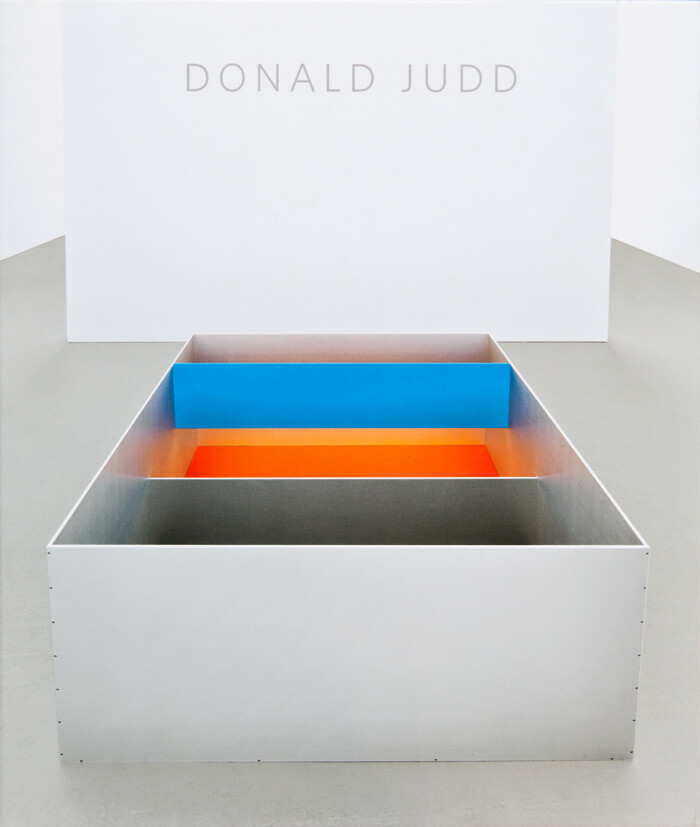The Helga and Walther Lauffs Collection
Texts by Jeffrey Weiss, Béatrice Gross, and Gila Strobel
This two-volume catalogue documents the collection of Helga and Walther Lauffs, one of Europe’s most important private collections of twentieth century post-war art, comprising key examples of Pop Art, Arte Povera, Minimalism, Post-Minimalism, and Conceptual Art.
The Lauffs built their collection over the course of the late 1960s through the 1970s with the guidance of curator and art historian Paul Wember, who was known for the visionary program of contemporary art that he developed as the director of the Kaiser Wilhelm Museum in Krefeld between 1947 and 1975. In its vision and scope, which is made evident by the rigorous and broad selection of the art of their times, they succeeded in building a collection that bridges the gap between European and American artistic sensibilities. Their collection provides a singularly focused overview of art produced around the 1960s and 1970s, offering connections among its diverse artworks, while pointing forward to the work of successive generations of artists.
In two fully-illustrated volumes, the catalogue incorporates over 100 color plates, with newly-commissioned scholarship and extensive research and documentation on the works in the collection, including important works by Joseph Beuys, Mel Bochner, Lee Bontecou, Christo, Joseph Cornell, Hanne Darboven, Jan Dibbets, Lucio Fontana, Eva Hesse, Donald Judd, On Kawara, Yves Klein, Joseph Kosuth, Sol LeWitt, Piero Manzoni, John McCracken, Mario Merz, Robert Morris, Bruce Nauman, Louise Nevelson, Claes Oldenburg, Giulio Paolini, Michelangelo Pistoletto, Fred Sandback, George Segal, Richard Serra, Richard Tuttle, Cy Twombly, Günther Uecker, Tom Wesselmann, and Douglas Wheeler, among other key artists of the twentieth century.
This clothbound, slipcased edition was published after a series of major exhibitions drawn from the Lauffs Collection in the Spring and Fall of 2008 at Zwirner & Wirth and David Zwirner, New York, and Hauser & Wirth, Zurich.
Publisher: Steidl/Zwirner & Wirth
Artists: John McCracken, Richard Serra, Dan Flavin, Donald Judd, Fred Sandback, On Kawara, Doug Wheeler
Contributors: Béatrice Gross, Gila Strobel, Jeffrey Weiss
Publication Date: 2010
Binding: Hardcover, 2 volumes in slipcase
Dimensions: 9 1/2 x 11 1/2 (24.1 x 29.2 cm)
Pages: 505
Reproductions: Illustrated throughout
ISBN: 9783865218506
Retail: $175 US & Canada | £115 | €156
Status: Not Available
John McCracken
John McCracken (1934-2011) developed his early sculptural work while studying painting at the California College of Arts and Crafts in Oakland in the late 1950s and early 1960s. While experimenting with increasingly three-dimensional canvases, the artist began to produce objects made with industrial materials, including plywood, sprayed lacquer, and pigmented resin, creating the highly reflective, smooth surfaces that he was to become known for.
Richard Serra
Richard Serra’s first solo exhibitions were held at the Galleria La Salita, Rome, 1966, and, in the United States, at the Leo Castelli Warehouse, New York, in 1969. His first solo museum exhibition was held at The Pasadena Art Museum in 1970. Solo exhibitions of Serra’s sculptural work have been held at numerous public institutions worldwide, including Kunsthalle Tübingen, Germany, 1978; Musée National d’Art Moderne, Paris, 1984; The Museum of Modern Art, New York, 1986; Museo Nacional Centro de Arte Reina Sofía, Madrid, 1992; Serpentine Gallery, London, 1992; and Dia Center for the Arts, New York, 1997.
All Richard Serra books
Dan Flavin
From 1963, when he conceived the diagonal of May 25, 1963 (to Constantin Brancusi), a single gold, fluorescent lamp that is installed on a diagonal on the wall—a work which marks the artist’s first use of fluorescent light alone, until his death in 1996, Dan Flavin (1933-1996) produced a singularly consistent and prodigious body of work that utilized commercially-available fluorescent lamps to create installations, or “situations” as he preferred to call them, of light and color. Through the construction of light, Flavin was able to literally establish and redefine space.
Donald Judd
The work of Donald Judd (1928–1994), one of the most significant American artists of the postwar period, has come to define what has been referred to as minimalist art—a label to which the artist strongly objected on the grounds of its generality. The unaffected, straightforward quality of Judd’s work demonstrates his strong interest in color, form, material, and space. With the intention of creating work that could assume a direct material and physical “presence” without recourse to grand philosophical statements, he eschewed the classical ideals of representational sculpture to create a rigorous visual vocabulary that sought clear and definite objects as its primary mode of articulation.
Fred Sandback
Fred Sandback (1943–2003) was an American artist known for sculptures that outlined planes and volumes in space. Though he employed metal wire and elastic cord early in his career, the artist soon dispensed with mass and weight by using acrylic yarn to create works that address their physical surroundings, the “pedestrian space,” as Sandback called it, of everyday life. By stretching lengths of yarn horizontally, vertically, or diagonally at different scales and in varied configurations, the artist developed a singular body of work that elaborated on the phenomenological experience of space and volume with unwavering consistency and ingenuity.
All Fred Sandback books
On Kawara
For over five decades, On Kawara created paintings, drawings, books, and recordings that examined chronological time and its function as a measure of human existence. His artistic practice was characterized by its meditative approach to concepts of time, space, and consciousness. He began making his now signature date paintings (known as the Today series) on January 4, 1966 in New York City and continued to produce them in different parts of the world up until his death.
Doug Wheeler
Doug Wheeler’s prolific and groundbreaking body of work encompasses drawing, painting, and installations that are characterized by a singular experimentation with the perception and experience of light, space, and sound. Raised in the high desert of Arizona, Wheeler began his career as a painter in the early 1960s while studying at the Chouinard Art Institute (now the California Institute of the Arts) in Los Angeles.



